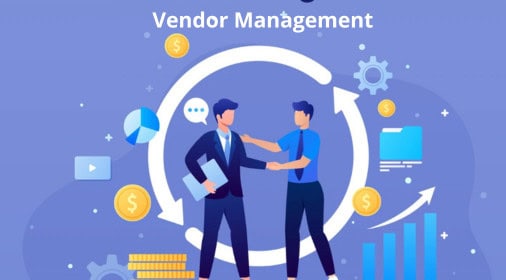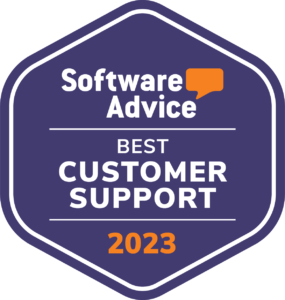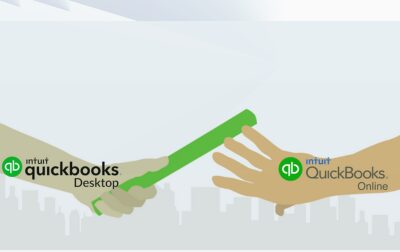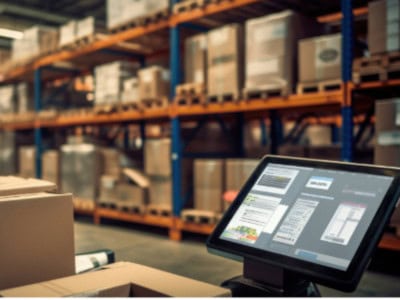What is Vendor Relationship Management?
What is Vendor Relationship Management (VRM) and Why It’s Essential for Your ERP and Inventory Software?
Let’s explore why these features are crucial for optimizing supplier relationships and driving business growth.
Why is Vendor Relationship Management Important?
1. Better Communication with Suppliers
Clear communication is the key to building strong supplier relationships. VRM tools within Kechie ERP and inventory system help streamline communication by supporting multiple contact management. This ensures that businesses can track and communicate with various people within a vendor’s organization, whether it's for accounting, sales, or support. Having all supplier contacts organized in one place makes it easier to collaborate and avoid confusion.
2. Vendor Contract Management
Vendor contracts are the backbone of supplier relationships, detailing terms, pricing, and obligations. Managing these contracts manually can be a challenge, but Kechie ERP with VRM tools streamlines automated contract tracking. This ensures that you stay on top of renewals, performance expectations, and compliance, helping you avoid missed deadlines or financial penalties.
3. Vendor GL Setup for Accurate Financial Management
Vendor GL setup is crucial for managing your finances effectively. In VRM systems integrated with Kechie ERP software, you can assign vendors to specific general ledger accounts. This allows businesses to track expenses, costs, and payments against the appropriate financial accounts. By automating this process, you reduce errors and improve financial reporting accuracy.
4. Emailing from the Software
VRM in Kechie ERP system also enables direct email communication with vendors from the software. This feature allows you to send purchase orders, contracts, invoices, or any other documents directly to suppliers without needing to switch between platforms. All communication is logged within Kechie ERP system, so you have a complete history of email interactions at your fingertips.
5. Managing Multiple Locations
Many businesses deal with vendors that have multiple locations. Whether you’re sourcing from different warehouses or shipping to various branches, VRM tools help track and manage vendors across multiple locations. This ensures that you have complete visibility into where products are coming from and going to, enabling smoother logistics and more effective supply chain management.
6. Monitor Supplier Performance
Tracking supplier performance is key to making informed decisions. Kechie ERP with VRM capability helps you monitor metrics like delivery times, product quality, and order consistency. This data is invaluable for evaluating suppliers, resolving disputes, or negotiating better terms.
7. Add Notes for Better Vendor Tracking
Keeping track of the nuances in vendor relationships is often overlooked, but it can make all the difference. VRM integrated with Kechie ERP system allows users to add notes to vendor profiles, capturing important details such as pricing discussions, special requests, or any unique preferences the supplier might have. These notes provide context for future interactions and ensure that important details are not lost.
8. Stronger Vendor Relationships
All this information centralized in Kechie ERP and VRM tool helps you maintain transparency and ensure vendors are well-informed and aligned with your business goals. Better communication, well-managed contracts, and organized vendor data lead to stronger, more reliable partnerships that benefit both parties in the long run.
9. Risk Management
The VRM tool within a system like Kechie ERP, you can track vendor compliance with industry standards and other regulatory requirements. This helps you assess risks, avoid supply chain disruptions, and maintain business continuity even during unforeseen circumstances.
Why You Need VRM Integrated with Your ERP and Inventory Software
Integrating VRM with a system like Kechie ERP or Kechie Inventory Software enhances supplier management in significant ways:
Centralized Data and Contact Management:
When VRM is part of your ERP like Kechie System, you can store all vendor data in one place, including GL account details, multiple contact information, contract data, and notes. This ensures consistency and makes it easier to access important information across departments.
Automated Workflows and Communication:
By automating key tasks—like sending emails, creating purchase orders, or tracking shipments—an integrated VRM system improves operational efficiency. The ability to email vendors directly from Kechie ERP software, while keeping all communication logged, enhances productivity and eliminates the need for external tools.
Multi-Location and Performance Tracking:
Managing vendors with multiple locations becomes seamless. Kechie ERP integrated with VRM tool allows you to track deliveries and orders across various sites, giving you a real-time overview of supply chain performance and logistical coordination.
Scalability and Real-Time Insights:
As your business expands, managing multiple vendors and locations can become increasingly complex. Kechie ERP integrated VRM systems scale with your business, ensuring that supplier management remains efficient. Real-time insights into vendor performance, financials, and procurement status help you make informed decisions quickly.
Conclusion
Vendor Relationship Management, when integrated with Kechie ERP and Kechie Inventory software, is essential for optimizing supplier communication, managing contracts, automating financial tracking, and improving overall procurement processes. Kechie ERP offers features such as vendor GL setup, multiple contact management, email integration, and multi-location handling to ensure your business can build stronger supplier relationships, minimize risks, and scale efficiently. This not only streamlines operations but also positions your business for long-term success in today’s competitive market.
Navigating the Complex World of Logistics: Strategies for Success
Navigating the Complex World of Logistics: Strategies for Success
The effectiveness of your logistics can mean the difference between skyrocketing profits and lost opportunities in a world where everything is connected more and more. Effective logistics management is crucial for businesses looking to streamline operations, reduce costs, and enhance customer satisfaction. Whether you’re managing a global supply chain or a local delivery service, mastering logistics can lead to significant competitive advantages.
What is Logistics Management?
Logistics management encompasses the planning, implementation, and control of the flow of goods, services, and information from origin to consumption. This complex process involves transportation, warehousing, inventory management, and order fulfillment, all aimed at ensuring that products reach customers in a timely and cost-effective manner.
Why is Logistics Management Important?
1. Cost Reduction: Efficient logistics can significantly lower transportation and warehousing costs, enhancing overall profitability.
2. Customer Satisfaction: Timely and accurate delivery is key to customer loyalty. Streamlined logistics ensure that customers receive their orders on time and in perfect condition.
3. Competitive Advantage: Companies that master logistics often outperform their competitors by offering better service levels, faster deliveries, and more responsive supply chains.
Key Strategies for Effective Logistics Management
1. Leverage Technology: Utilize logistics software and tools for real-time tracking, inventory management, and data analytics. This helps streamline processes and improve decision-making.
2. Optimize Your Supply Chain: Regularly assess and refine your supply chain network to enhance efficiency. Identify bottlenecks and seek opportunities for improvement.
3. Build Strong Relationships with Partners: Collaborating closely with suppliers, carriers, and other partners can lead to smoother operations and better problem-solving.
4. Focus on Sustainability: Implement eco-friendly practices in your logistics operations. Not only does this reduce environmental impact, but it can also appeal to socially conscious consumers.
5. Train Your Team: Invest in training for your logistics staff to ensure they are equipped with the latest best practices and technologies.
Streamlining Your Logistics for Success
Navigating the complexities of logistics is essential for any business striving for success in today’s market. By implementing effective strategies and adopting technology available in robust ERP Systems, you can optimize your logistics processes, reduce costs, and enhance customer satisfaction. In a world where speed and efficiency are important, managing logistics is not just an option—it’s a necessity for growth.
Transforming Logistics with Kechie ERP Solutions
To take your logistics management to the next level, consider implementing a fully integrated ERP system like Kechie ERP. This advanced tool can streamline your logistics operations by centralizing information and automating critical processes. With Kechie ERP, you can:
1. Enhance Visibility: Gain access to real-time data on inventory levels, shipment statuses, and supplier performance. This clarity enables you to make informed decisions swiftly, ensuring that your logistics operations run smoothly and effectively.
2. Optimize Your Processes: Automate routine logistics tasks such as order tracking and inventory management. This automation frees your team to concentrate on strategic planning and problem-solving, enhancing overall productivity.
3. Improve Collaboration Across Teams: Foster seamless communication between departments and external partners. With everyone aligned, you can work together toward common goals, driving efficiency and reducing potential delays.
4. Drive Cost Efficiency: Utilize logistics data to pinpoint inefficiencies and identify opportunities for cost reduction. This insight helps you optimize your operations and improve your bottom line.
5. Support Your Sustainability Initiatives: Leverage advanced analytics to assess and select eco-friendly logistics options. This commitment to sustainable practices reinforces your organization’s values and enhances your reputation in the market.
By entering detailed logistics data into Kechie ERP System, businesses can gain real-time view of their supply chain operations, from procurement to fulfillment. Kechie ERP seamlessly connects all modules, transforming logistics from a reactive function to a proactive one–driving efficiency, enhancing customer satisfaction, and gaining a significant competitive edge in the marketplace.
Connect with us today, our expert team is here to guide you through the process and help you discover the transformative potential of our solutions.
Stay tuned for our series of insightful blogs—your roadmap to exploring the full potential of ERP.
In This Article
-Why is Logistics Management Important?
• Cost Reduction
• Customer Satisfaction
• Competitive Advantage
-Key Strategies for Effective Logistics Management
• Leverage Technology
• Optimize Your Supply Chain
• Build Strong Relationships with Partners
• Focus on Sustainability
• Train Your Team
-Streamlining Your Logistics for Success
-Transforming Logistics with Kechie ERP Solutions
•Enhance Visibility
•Optimize Your Processes
•Improve Collaboration Across Teams
•Drive Cost Efficiency
•Support Your Sustainability Initiatives
QuickBooks Desktop is Phasing Out -Tips for Transitioning to QuickBooks Online
The State of QuickBooks Desktop – Tips for Transitioning to QuickBooks Online
For years, QuickBooks Desktop has been the trusted accounting software for businesses of all sizes. But as the world of accounting evolves with the rise of cloud computing, QuickBooks Online (QBO) is becoming the go-to solution for companies seeking real-time collaboration, mobility, and scalability.
With over 80% market share in the U.S. small business accounting segment, QuickBooks remains a dominant player. However, Intuit has announced that support for QuickBooks Desktop 2022 will end in May 2025, making it critical for businesses to plan their transition to QuickBooks Online. In this blog, we’ll explore the consequences of not transitioning by the deadline, how to ensure a smooth migration, and an alternative solution for businesses needing more advanced functionality than QBO can offer.
With over 80% market share in the U.S. small business accounting segment, QuickBooks remains a dominant player. However, Intuit has announced that support for QuickBooks Desktop will end in May 2025, making it critical for businesses to plan their transition to QuickBooks Online. In this blog, we’ll explore the consequences of not transitioning by the deadline, how to ensure a smooth migration, and an alternative solution for businesses needing more advanced functionality than QBO can offer.
Why Transition from QuickBooks Desktop to QuickBooks Online?
QuickBooks Online offers numerous benefits for modern businesses. With QBO, you can:
- Access your financial data from anywhere, anytime, thanks to cloud-based storage.
- Collaborate in real time with your team, no matter where they’re located.
- Automatically back up your data and receive regular software updates.
- Integrate with hundreds of apps and tools that boost operational efficiency.
Currently, 7 million businesses rely on QuickBooks Online, making it the most popular cloud accounting solution in the U.S. However, businesses that stick with QuickBooks Desktop past the May 2025 deadline will face significant risks, including security vulnerabilities, lack of support, and higher costs for rushed migrations.
The Consequences of Not Transitioning by May 2025
After May 2025, Intuit will stop supporting QuickBooks Desktop. Here’s what that means for your business if you don’t make the switch in time:
1. Security Risks: Without updates and patches, your financial data becomes vulnerable to cyber threats.
2. Loss of Technical Support: If something goes wrong, you won’t have access to QuickBooks customer support to help troubleshoot issues.
3. Software Incompatibility: QuickBooks Desktop will become harder to integrate with modern apps and banking platforms, making it less functional over time.
4. Increased Costs: A last-minute transition could require additional resources, driving up migration costs.
The transition to QBO is not just about staying supported—it's about embracing a system designed for today’s business needs.
How to Ensure a Smooth Transition to QuickBooks Online
Migrating to QBO doesn’t have to be difficult if you prepare properly. Here are a few best practices to make your transition seamless:
1. Evaluate Your Business Needs: Determine if QBO offers all the features you need for your industry, such as multi-currency support, advanced reporting, or inventory management.
2. Backup Your Data: Before starting the migration, ensure all of your QuickBooks Desktop data is securely backed up to avoid any data loss.
3. Choose the Right Plan: QuickBooks Online offers multiple subscription tiers. Make sure to pick the one that best matches your business needs.
4. Train Your Team: Get your team up to speed on how to use QuickBooks Online by offering training sessions before you fully migrate.
Need More Advanced Features? Consider Kechie ERP
While QuickBooks Online is a great option for many businesses, it may not have all the features your company requires. If you need more advanced functionality, like deeper reporting, more robust inventory management, or industry-specific tools, Kechie ERP is a powerful alternative.
One of the standout benefits of Kechie ERP is its two-way sync with QuickBooks Online. This seamless integration ensures that data flows smoothly between Kechie ERP and QBO, eliminating the need for manual data entry or duplicate records. By automating these processes, you save time, reduce errors, and keep your operations running smoothly.
With Kechie ERP, you can take advantage of advanced functionality while maintaining all the benefits of QuickBooks Online. You get the best of both worlds—scalability, flexibility, and cloud-based access with the added power of Kechie ERP’s enhanced features.
Conclusion
The countdown to the May 2025 QuickBooks Desktop deadline has begun. Now is the time to start planning your transition to QuickBooks Online. By acting early, you can avoid the risks associated with outdated software, ensure your data is secure, and future-proof your accounting operations.
If you’re looking for more advanced features, consider Kechie ERP, which integrates seamlessly with QuickBooks Online. The two-way sync between Kechie ERP and QBO helps eliminate manual work, saving you time and reducing costly mistakes.
Connect with us today, our expert team is here to guide you through the process and help you discover the transformative potential of our solutions.
Stay tuned for our series of insightful blogs—your roadmap to exploring the full potential of ERP.
What is an RMA and Why Does It Matter?
What Is An RMA and Why Does It Matter?
An RMA (Return Merchandise Authorization) is a system that allows customers to return products in a structured way, ensuring everything runs smoothly. Whether you're a small retailer or a large corporation, having an RMA process in place helps streamline returns, reduces headaches, and makes sure your customers feel taken care of.
Breaking Down the RMA Process
Here’s how a typical RMA process can be enhanced with Kechie ERP:
1. Customer Request: The customer initiates a return request due to defects, wrong sizing, or other issues. With Kechie ERP, this request is automatically logged into the system, streamlining communication and tracking.
2. Authorization: Once the business verifies the request against the return policy, Kechie ERP generates and issues an RMA number automatically, ensuring accuracy and efficiency.
3. Return Shipping: The customer ships the product back, clearly labeling it with the RMA number. Kechie ERP tracks the shipment, updating its status in real-time.
4. Inspection & Resolution: When the item is received, it is inspected, and Kechie ERP triggers the next steps. If the return meets the criteria, the system processes a refund or initiates a replacement, updating the customer throughout the process.
This process helps businesses keep track of returns and makes it easier to manage inventory. It also gives customers confidence that their return will be handled quickly and fairly.
Why an RMA System is a Must-Have for Businesses
A well-managed RMA system, like the one in Kechie ERP, can make all the difference. Here’s why:
- Simplifies Returns: Without an RMA, returns can become a chaotic mess. Kechie ERP streamlines the return process, making it easier for both you and your customers.
- Reduced Fraud Risk: Tracking each return with an RMA number reduces the risk of fraudulent claims.
- Improves Customer Experience: A seamless return process with Kechie ERP leads to happier customers, and increases loyalty.
- Keeps Inventory in Check: Kechie ERP’s RMA tracking returns means you’re less likely to end up with stock discrepancies or missing items.
How RMA Software Can Streamline Your Returns
As businesses grow, managing returns manually becomes more challenging. That’s where RMA software comes in. With the right tool, you can automate the process, ensuring faster response times and fewer mistakes.
Kechie ERP provides full automation in your RMA process, making the whole return cycle—from request to resolution—a breeze. Kechie is fully integrated, so all your transactions are done in real-time and all the relevant modules are updated, from issuing credits to customers in the accounting module to replacements/cross shipments in logistics, are done for you in the background. This not only saves time but also ensures consistency across your business operations.
Conclusion: RMA is More Than Just a Number
At its core, an RMA system is about making returns easier for everyone involved. For businesses, it provides better control and visibility over returns, and for customers, it ensures a clear, straightforward process. Whether you're handling a handful of returns or hundreds, having a solid RMA process in place is crucial for keeping operations running smoothly.
Connect with us today, our expert team is here to guide you through the process and help you discover the transformative potential of our solutions.
Stay tuned for our series of insightful blogs—your roadmap to exploring the full potential of ERP.
My Office Apps Announces The Launch Of SupplierHub
My Office Apps (MOA) Announces New Capability for Kechie ERP: SupplierHub
IRVINE, Calif., September 17, 2024 /PRNewswire/ — MOA a leading provider of cloud-based ERP solutions, is proud to announce the launch of SupplierHub, a new capability integrated into its flagship Kechie ERP system.
This latest enhancement introduces a comprehensive supplier management feature that allows businesses to collaborate with suppliers directly, order products seamlessly through a centralized portal, and automate the entire procurement process.
Key Benefits of SupplierHub Include:
- Supplier Collaboration: SupplierHub enables suppliers to add and update their available items directly within the system, ensuring businesses always have access to the most up-to-date inventory information.
- Direct Ordering: Businesses can review items from their suppliers in SupplierHub and place orders with a single click, eliminating the need for manual processes.
- Automated Purchase Orders: Once an order is placed, Kechie ERP automatically converts it into a purchase order, which is sent directly to the supplier, expediting the procurement cycle.
- Real-Time Integration: SupplierHub operates within the Kechie ERP ecosystem, ensuring that all transactions, updates, and inventory data are synchronized in real time.
Read more on Cision PR Newswire
How KPIs Can Improve Operations with ERP Software.
How Key Performance Indicators (KPIs) Can Improve Operations with ERP Software
What Are KPIs?
A KPI is a number or metric that tracks how well your business is doing in a certain area. For example, you could measure how fast orders are fulfilled, how satisfied your customers are, or how much revenue your business is generating. These metrics give you clear data on what’s working and what needs improvement.
Some common KPIs include:
- Revenue Growth: Tracks how much your income is increasing over time.
- Order Fulfillment Time: Measures how quickly you process and ship customer orders.
- Customer Satisfaction: Assesses how happy customers are with your service.
How ERP Software Helps Track KPIs
ERP software, like Kechie ERP, is designed to manage and automate many areas of your business, from inventory and order management to finance and HR. One of the key benefits of Kechie ERP software is its ability to track and analyze KPIs in real time. Here’s how ERP and KPIs work together:
1. Centralized Data
With Kechie ERP software, all your business data is stored in one system. This makes it easy to track KPIs across departments like sales, inventory, and finance without switching between different tools.
2. Automated Tracking
Kechie ERP automatically collect data and generate KPI reports. You can monitor key metrics like inventory turnover, production efficiency, and sales performance without manually updating spreadsheets.
3. Real-Time Insights
With real-time data available through Kechie ERP, you can track KPIs instantly. This allows for faster decision-making and quick responses to any issues that arise, helping to keep your operations running smoothly.
4. Customizable Dashboards
Kechie ERP software offers customizable dashboards where you can display the KPIs that matter most to your business. This makes it easy for you and your team to stay focused on important performance goals.
Why KPIs Are Important for ERP-Driven Operations
Within Kechie ERP software, KPIs play a crucial role in improving operational efficiency. Here’s why they matter:
1. Better Decision-Making
Kechie ERP provide detailed data on every aspect of your business. By analyzing KPIs included in our software, you can make informed, data-driven decisions that improve processes and boost profitability.
2. Improved Operational Efficiency
Tracking KPIs like order fulfillment time or inventory turnover helps you identify areas where processes are slow or inefficient. Kechie ERP gives you the tools to adjust workflows and optimize operations based on these metrics.
3. Goal Alignment
Kechie ERP helps align your KPIs with your business goals. For example, if your goal is to reduce costs, you can track KPIs related to production efficiency and material usage. Kechie ERP will provide real-time insights into how well you are achieving those goals.
4. Accountability Across Teams
With a robust software like Kechie ERP, you can assign specific KPIs to departments or team members. This promotes accountability and ensures everyone is working toward the same objectives, like improving productivity or reducing waste.
Examples of KPIs to Track in ERP Software
Here are some key KPIs that Kechie ERP can help you monitor:
1. Inventory Turnover: Tracks how quickly you sell and restock inventory, helping to optimize stock levels.
2. Order Fulfillment Time: Measures how long it takes to process and ship customer orders, which is key for customer satisfaction.
3. Production Efficiency: Tracks how effectively your resources are being used in manufacturing.
4. Employee Productivity: Measures how much work is done by each employee to identify areas for improvement.
Conclusion: Boost Your Business with Kechie ERP and KPIs
KPIs are vital for understanding how your business is performing, and Kechie ERP software makes it easier to track and improve those metrics. By combining KPIs with the power of Kechie ERP system, you gain real-time insights, automated tracking, and better control over your operations. This helps you make smarter decisions and run a more efficient business.
Start using KPIs within Kechie ERP today to improve operations, boost productivity, and drive long-term success.
Connect with us today, our expert team is here to guide you through the process and help you discover the transformative potential of our solutions.
Stay tuned for our series of insightful blogs—your roadmap to exploring the full potential of ERP.
What Is an Item Type and How Is It Managed Within ERP Software?
What Is an Item Type and How Is It Managed Within ERP Software?
What are the different types of items you need to know about in your business?
1. Standard Items
Standard items are the backbone of most inventory systems. These are individual products that are tracked based on quantity. With ERP software like Kechie ERP, managing standard items becomes a breeze. The system tracks every unit, ensuring accurate stock levels and preventing both overstocking and stockouts.
2. Serialized Items
Serialized items are products that require unique serial numbers for tracking purposes. These are often high-value or regulated items, like electronics or medical devices. With the help of Kechie ERP software, businesses can track each item individually, ensuring compliance with industry regulations and providing detailed records of each item's history.
3. Lot-Tracked Items
Lot-tracked items are grouped by batch or production run, often with an expiration date. This is particularly important in industries like food and pharmaceuticals, where traceability is crucial. A system like Kechie ERP can efficiently manage lot numbers, making it easier to track product batches throughout the supply chain and recall items if necessary.
4. Perishable Items
Perishable items have a limited shelf life and require careful management to minimize waste. Kechie ERP helps track expiration dates and manage stock rotation to ensure freshness and compliance, especially in industries like food and pharmaceuticals.
5. Service Items
Service items represent services rather than physical goods, such as consulting or repair services. Kechie ERP system can track service hours, manage service contracts, and ensure accurate billing and resource allocation.
6. Digital Items
Digital items include software, licenses, or digital content. A system like Kechie ERP helps manage these items by tracking licenses, usage, and updates, ensuring compliance and efficient distribution.
7. Consumables
Consumables are items that are used up or discarded after use, such as office supplies, packaging materials, or raw materials in manufacturing. Proper management of consumables with Kechie ERP system ensures that you always have the necessary supplies on hand, avoiding production delays or stockouts.
8. Bundles or Kits
Bundles or kits are combinations of individual items sold together as a package. Managing these in Kechie ERP system allows businesses to track each component of the bundle separately while also managing the bundle as a single SKU. This is particularly useful for promotions or product sets.
9. Manufactured Items
Manufactured items are products created from raw materials and components. Kechie ERP software streamlines the production process by managing the bill of materials (BOM), tracking work in progress (WIP), and ensuring that all components are available when needed. This leads to increased efficiency and reduced production costs.
Conclusion
An ERP or inventory management software is an essential tool for managing the diverse range of items or SKUs in your business. Whether you’re dealing with standard products, serialized items, or complex bundles, Kechie ERP can help you maintain control, ensure accuracy, and optimize your operations.
Investing in a robust ERP solution like Kechie ERP can transform how you manage your inventory, leading to greater efficiency and profitability. Start optimizing your inventory today!
Connect with us today, our expert team is here to guide you through the process and help you discover the transformative potential of our solutions.
Stay tuned for our series of insightful blogs—your roadmap to exploring the full potential of ERP.
What Is MRP and How Does It Work?
What Is MRP and How Does It Work? A Straightforward Guide
MRP: The Basics
MRP, or Material Requirements Planning, is a system that helps manufacturers figure out exactly what materials they need, when they need them, and in what quantities. It’s all about making sure you have enough parts and materials to keep production rolling, but without overstocking and tying up too much cash in inventory.
How Does MRP Work?
Kechie MRP operates on three basic principles: managing inventory, scheduling production, and ensuring timely procurement of materials. Here's how it works:
1. Master Production Schedule (MSP): This is basically your game plan. It tells you what products need to be made and when they should be ready. The MPS drives the whole MRP process, ensuring that you’re producing the right stuff at the right time.
2. Bill of Materials (BOM): Think of the BOM as your recipe. It lists all the ingredients (materials and components) needed to make a product. MRP uses the BOM to figure out exactly what you need to order and when. This step is critical for accurate planning and scheduling
3. Inventory Records: Accurate inventory records are key. These records show what materials you already have on hand and what’s still on the way. With this info, MRP can plan out material orders so you’re not overstocking or running out of anything.
With these pieces in place, Kechie MRP works to calculate what you need, when you need it, and how much you need to keep production humming along without any hiccups.
Why MRP Matters
1. Better Inventory Management: MRP helps you avoid the classic pitfalls of having too much or too little inventory. By ordering materials just when you need them, you cut down on storage costs and reduce waste.
2. Smoother Production Scheduling: With MRP, your production schedule is closely aligned with actual demand. This means fewer delays and a better chance of delivering products on time.
3. Cost Efficiency: When your inventory and production processes are in sync, you save money. It’s that simple.
4. Flexibility: Things change—demand fluctuates, suppliers have delays. MRP gives you the flexibility to adjust your plans quickly so you can keep production on track.
Conclusion
MRP, or Material Requirements Planning, is a must-have for any manufacturer looking to streamline operations. It takes the guesswork out of ordering materials and scheduling production, which leads to better efficiency, lower costs, and happier customers. Whether you’re running a small shop or a large manufacturing operation, understanding and using MRP can make a big difference in your bottom line.
So, if you’re serious about improving your manufacturing process, it’s worth taking the time to get to know MRP. It might just be the tool you’ve been looking for.
Connect with us today, our expert team is here to guide you through the process and help you discover the transformative potential of our solutions.
Stay tuned for our series of insightful blogs—your roadmap to exploring the full potential of ERP.
5 Key Benefits of Bin Location Control in Distribution Management Solutions
5 Key Benefits of Bin Location Control in Distribution Management Solutions
What is Bin Location Control?
Bin location control refers to the systematic organization of inventory within a warehouse using designated storage locations, or "bins." Each bin is assigned a unique identifier, which is then used to track the exact location of every item in the warehouse. This systematized approach allows for precise inventory tracking and management.
Key Benefits of Bin Location Control
1. Enhanced Inventory Accuracy:
-
- With bin location control, each item is tracked to a specific location within the warehouse. This eliminates the guesswork and significantly reduces errors associated with inventory management. Accurate inventory records mean fewer stockouts, overstock situations, and discrepancies during audits.
2. Improved Picking Efficiency:
-
- By organizing inventory into specific bins, warehouse staff can quickly locate items for order fulfillment. This streamlines the picking process, reduces the time spent searching for products, and speeds up order processing, leading to faster delivery times and improved customer satisfaction.
3. Optimized Storage Utilization:
-
- Bin location control allows for better space management within the warehouse. Items can be strategically placed based on their size, frequency of access, or turnover rate. This optimal use of space can lead to reduced storage costs and more efficient warehouse operations.
4. Facilitates Cycle Counting:
-
- Regular inventory audits, or cycle counting, become much easier and more accurate with bin location control. Warehouse staff can systematically verify inventory levels in specific bins, ensuring ongoing accuracy without the need for disruptive full-scale inventory counts.
- Random spot checks of inventory can uncover issues such as stocking errors, order inaccuracies, storage problems, or theft, helping to maintain accurate records and prevent losses.
5. Enhanced Stock Rotation:
-
- Bin location control supports effective stock rotation practices, such as FIFO (First In, First Out). By tracking the age and movement of inventory within specific bins, companies can ensure that older stock is used or sold before newer stock, reducing the risk of obsolescence and spoilage.
How Bin Location Control Integrates with ERP Software
Kechie ERP integrates bin location control as a core functionality, enhancing your distribution management with advanced capabilities:
1. Systematic Organization:
-
- Kechie ERP assigns unique identifiers to each bin location within the warehouse. These identifiers are used to record the exact placement of each inventory item.
2. Real-Time Tracking:
-
- As items are received, moved, or picked, their locations are updated in real-time within Kechie ERP. This ensures that the inventory records are always up-to-date and accurate.
3. Automated Processes:
-
- Kechie ERP automates various processes, such as replenishment alerts for bins running low on stock, guided picking routes for warehouse staff, and automated cycle counting schedules. The barcode scanning capability in Kechie ERP further streamlines these processes by reducing manual entry and minimizing errors.
4. Reporting and Analytics:
-
- Kechie ERP provides comprehensive reporting and analytics on inventory levels, movement patterns, and storage efficiency. This data helps in making informed decisions about inventory management and warehouse operations.
Implementing Bin Location Control: Best Practices
1. Plan Your Layout:
-
- Design your warehouse layout with bin locations in mind. Consider the size and weight of items, frequency of access, and logical groupings.
2. Label Clearly:
-
- Ensure that all bins are clearly labeled with their unique identifiers. Use durable labels and make sure they are easy to read.
3. Train Staff:
-
- Provide comprehensive training for warehouse staff on the importance of bin location control and how to use the inventory management software effectively.
4. Monitor and Adjust:
-
- Regularly review your bin location strategy and make adjustments as needed. This could involve reassigning bins based on changing inventory patterns or optimizing space utilization.
Conclusion
Bin location control is a vital component of effective distribution management. By implementing this functionality within Kechie ERP, you can achieve greater inventory accuracy, improved picking efficiency, optimized storage utilization, and enhanced overall productivity. In the highly competitive market of modern distribution, these benefits can make a significant difference in your operational success. Streamline your distribution workflow and gain efficiency by implementing bin location control with Kechie ERP.
Connect with us today, our expert team is here to guide you through the process and help you discover the transformative potential of our solutions.
Stay tuned for our series of insightful blogs—your roadmap to exploring the full potential of ERP.
8 Essential Features for Efficient Contract Management
8 Essential Features For Effective Contract Management
Kechie’s Contract Management Features:
1. Easily View & Update Customer Contracts
One of the fundamental features of a robust contract management system is the ability to view and update customer contracts easily. Kechie ERP's contract management functionality allows users to quickly access contract details, making it simpler to review terms, track amendments, and make necessary updates. With an intuitive interface, users can efficiently navigate through contract data, ensuring that information is current and accurate.
2. Automated Deferred Revenue Recognition
Deferred revenue recognition can be a complex and time-consuming task, especially for businesses with numerous contracts. Kechie ERP simplifies this process by automatically calculating and recording revenue as it is earned over time. This ensures compliance with accounting standards and provides accurate financial reporting, reducing the risk of errors and improving efficiency.
3. Intelligent Contract Tracking and Notifications
Keeping track of critical contract dates and milestones is crucial for effective contract management. Kechie ERP provides intelligent contract tracking and notifications, offering automated alerts for key events such as renewal dates, expiration dates, and performance milestones. This proactive approach helps prevent missed deadlines, ensuring that necessary actions are taken on time and enhancing overall contract performance.
4. Fully Integrated with the AR Module
Integration with the Accounts Receivable (AR) module is essential for seamless financial operations. Kechie's contract management system is fully integrated with the AR module, enabling real-time synchronization of contract data with financial records. This integration ensures that billing, payments, and revenue recognition are accurately reflected in the company's financial statements, promoting consistency and reliability.
5. Real-Time Visibility and Integration
Real-time visibility and integration across various business functions are critical for effective decision-making. Kechie ERP's contract management system provides real-time capabilities, allowing stakeholders to access up-to-date contract information and performance metrics at any time. This level of transparency fosters better collaboration, improves responsiveness to changes, and supports strategic planning.
6. Run Reports on Contracts
Generating comprehensive reports on contract performance and status is vital for informed management. Kechie ERP enables users to create detailed reports on various aspects of contracts, such as revenue forecasts, compliance status, and renewal rates. These insights provide valuable data for evaluating contract effectiveness and identifying areas for improvement.
7. Set-up & Manage Contract Renewals
Managing contract renewals can be a tedious process, but it is crucial for maintaining ongoing business relationships. Kechie ERP facilitates easy set-up and management of renewals, ensuring that contracts are renewed on time and under favorable terms. Automated renewal workflows and reminders streamline the process, reducing administrative burden and enhancing continuity.
8. Create & Manage Contracts by Term Type
Businesses often deal with a variety of contract types, each with different terms and conditions. Kechie ERP's ability to create and manage contracts by term type is an essential feature of a versatile contract management system. This functionality allows users to customize contract templates and workflows based on specific term types, ensuring that each contract is handled appropriately and efficiently.
Conclusion
Modern contract management systems equipped with these functionalities can significantly enhance the efficiency and effectiveness of managing customer contracts. By streamlining processes, ensuring compliance, and providing valuable insights, Kechie ERP helps businesses maintain strong contractual relationships and achieve better financial outcomes. Investing in Kechie ERP's comprehensive contract management solution is a strategic move that can yield substantial benefits in the long run.
Connect with us today, our expert team is here to guide you through the process and help you discover the transformative potential of our solutions.
Stay tuned for our series of insightful blogs—your roadmap to exploring the full potential of ERP.





















